An in-depth guide to flounder fishing looking at all aspects of fishing for this fun, hard-fighting species from beaches, estuaries and boat.
Fishing for flounder is a rewarding pastime. They're one of the easiest species to catch, abundant and in areas that even the most novice sea angler can easily target. Preferring to hunt close to the shoreline of beaches, estuaries and creeks, they can often be fished for just a few yards out and with simple tactics. Ask a sea angler what fish they first recall catching, and it will likely be a flounder. In this guide, we take a look at how to target flounder from the beach, estuary and a boat.
Although the flounder is quite distinct, there can be confusion between this, the plaice and the dab.
The main difference with the flounder is that it has a series of prickles along the forward lateral line just above the pectoral fin. If you look at the plaice, this has a series of raised bony knobs. The dab has neither of these but look at the lateral line above the pectoral fin, and this shows a clear high upwards curve and is unique to the dab.
A common mistake made by anglers is wrongly identifying a flounder as a plaice because it has faint orangey/yellow spots on the topside. Both can show orangey-yellow spots on the back, though typically those on the plaice are much more defined, those on the flounder are diffused and lacking real colour. Flounder can occasionally cross breed with plaice.
Flounder can vary a little in colour. Over sand, they can be a light fawn to dark brown, but when living on mud or shingle will take on a grey/green colouration, sometimes with darker mottling.
Though an inshore fish, flounder migrate offshore into deep water to spawn. This is typically in the period from November to March. They begin returning as thin, spent fish as early as mid-March in the south, but typically mid-April further north.
Their diet is made up of worms, broken shellfish including cockles, clams, mussels and razorfish, shrimps, crabs, but they are also somewhat predatory. They will take small fish such as sand eels and fry.
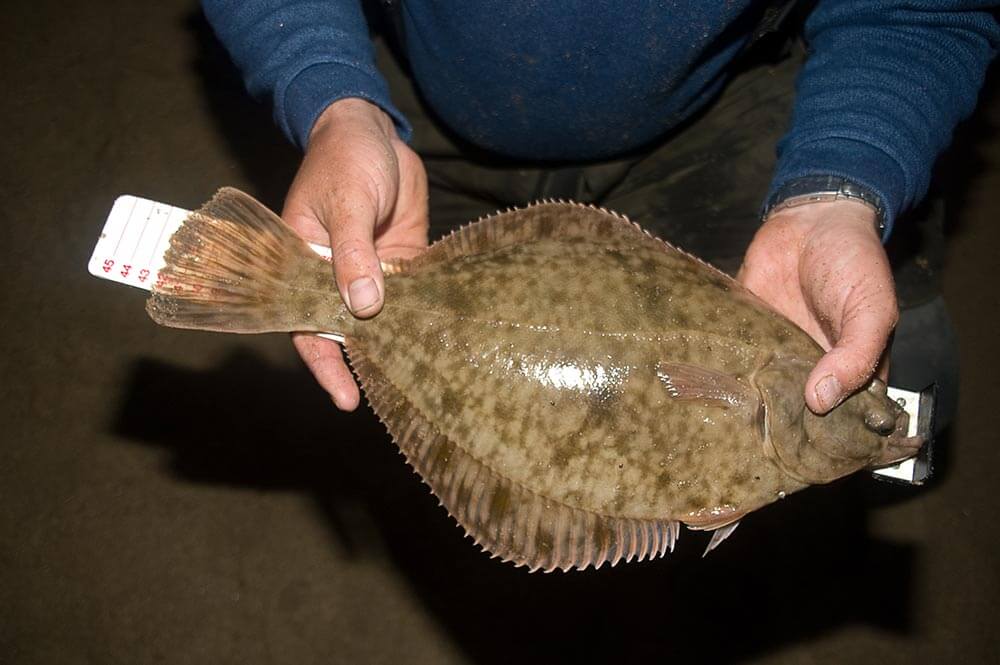
Flounder is one of our commonest and most adaptive fish being found throughout the British Isles, and also all around the coast of Ireland. They are also found as far north as the Faroe Islands and the southern tip of Iceland, and from the Russian border south taking in Norway and the western coast of Europe down to the Mediterranean.
Although flounder can be caught throughout the year in most areas, the recognised season for flounder fishing is from March when the spent fish return, to February when the bulk of the fish have moved offshore. The best period for the biggest fish is from October as the first real frosts arrive through to late January. At this time the fish are fully fat after a summer feeding and are powerful deep, thick-set fish.
They are found in higher numbers on the beaches adjacent to estuaries but can also be caught on open beaches well away from any freshwater influence. They favour clean sand, or mud and sand mixes, but will also happily live tight into mussel beds and in amongst rocks and boulders on small patches of clean sand.
Good spots on open beaches to locate flounder are small freshwater streams that flow across the beach, but only if the water is clear. If such water carries colour and is acidic from the mountains, or peat stained when in Ireland, then fish move away from these to purer water. Flounder, like so many other fish, hunt the parallel gullies that many storm beaches have, and will also settle down in hollows and deeper gutters feeding on foodstuffs washed down to them.
Flounder move inshore with the tide and feed right in amongst the last two surf tables happy in shallow water just a few inches deep. They drop back with the ebbing tide but do not move far away from the surf tables and are often one of the few fish that will continue to feed well as the tide ebbs away.
There is a myth that flounder do not feed at night. Flounder are masters of camouflage and care little whether its daylight or dark. Often the biggest flounder are caught at night when they venture closest in along the surf beaches, and especially after a good blow has ripped shellfish from the sand in the autumn.
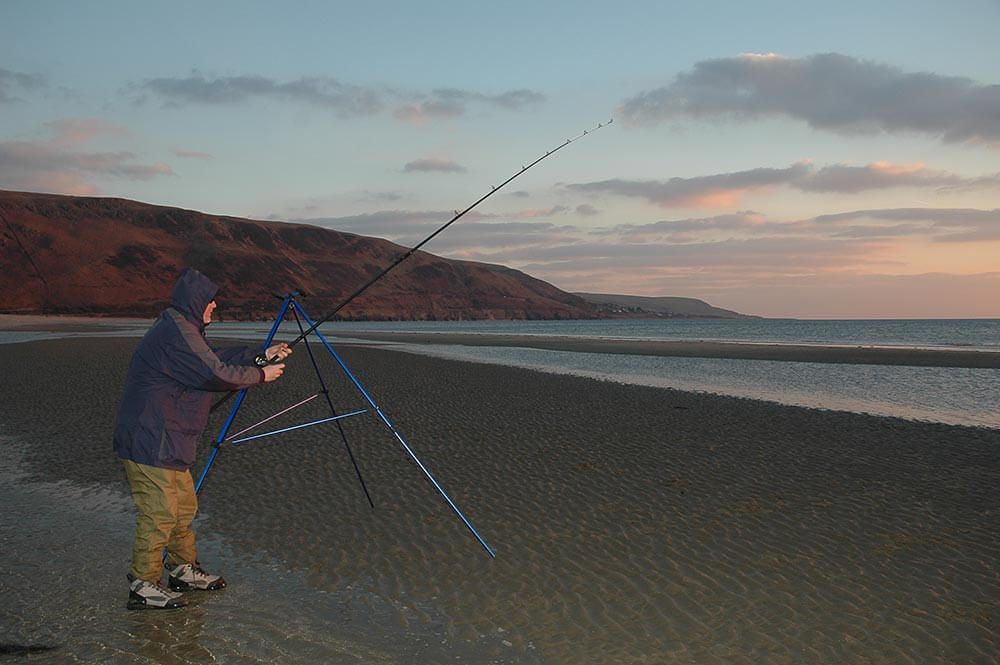
The majority of flounders caught by anglers are taken on heavy 4-6oz beachcasters when fishing for other species. But for most situations, you can fish a lot lighter. A good bass rod capable of casting either 1 to 3ozs or 2-4ozs is a good choice matched to a 6000 sized fixed spool or light multiplier reel. Load these reels with just 12lb line and a 30lb shock leader as casting distances will be no more than 50yds.
More experienced anglers go as light as a 9ft spinning rod, and a 4000 sized fixed spool reel loading with 10lb braid or mono and fish light lead weights no more than an ounce when appropriate to maximise sport. A simple sliding flowing trace rig with a size 2 Aberdeen works well with this combination when fishing up to 50yds out in the advancing surf tables.
How to tie a three-hook boom rig
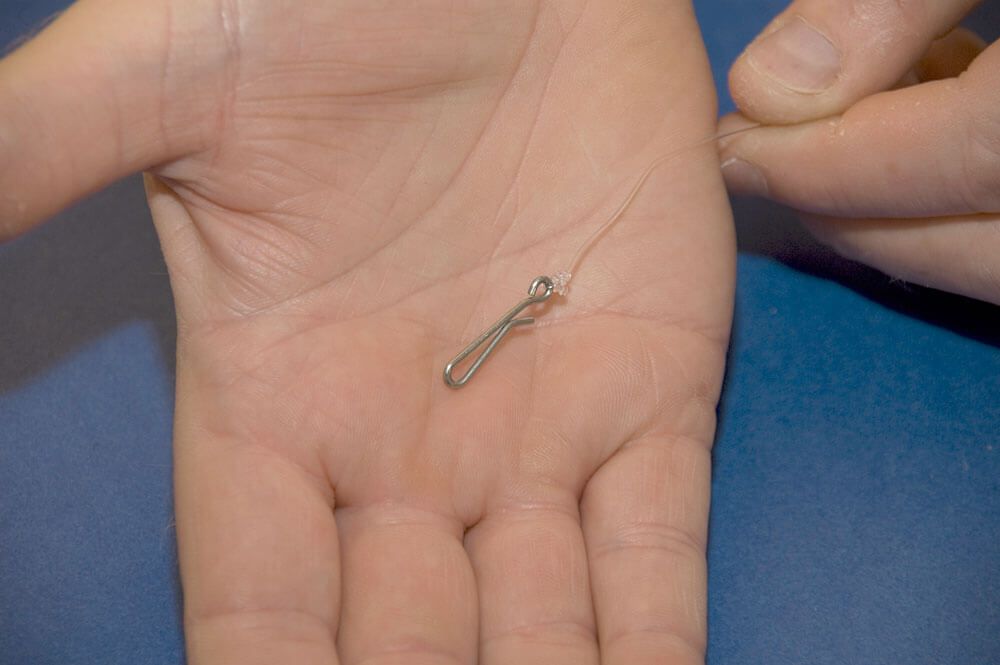
1. Start the rig with 60-inches of clear 60lb rig body line and tie a lead link to one end.
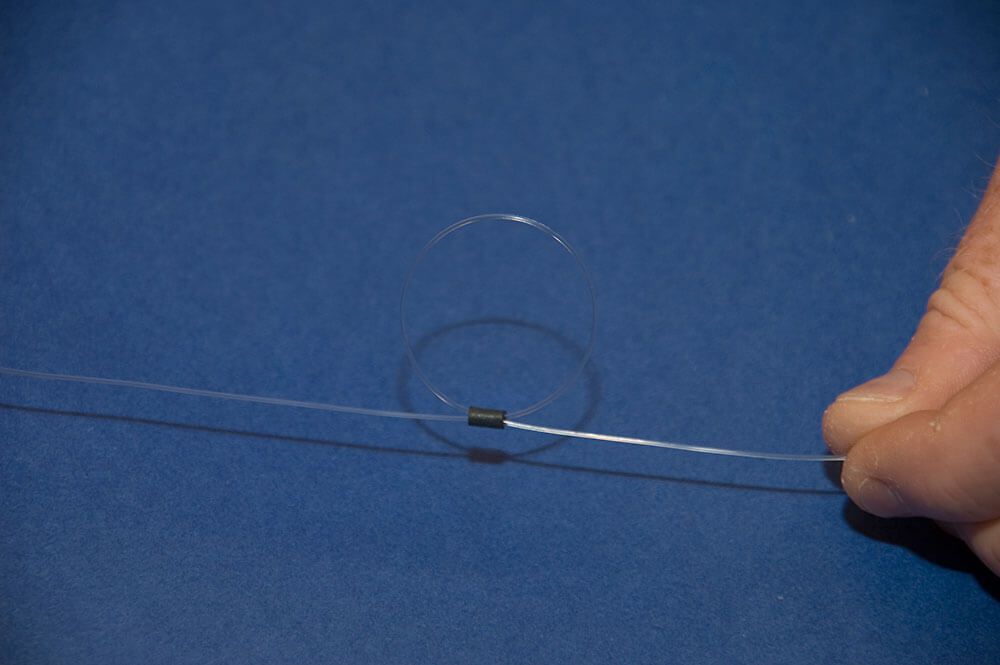
2. Slide on a short section of neoprene tubing and double the line back through the tubing then pull tight to form a sliding rig stop.
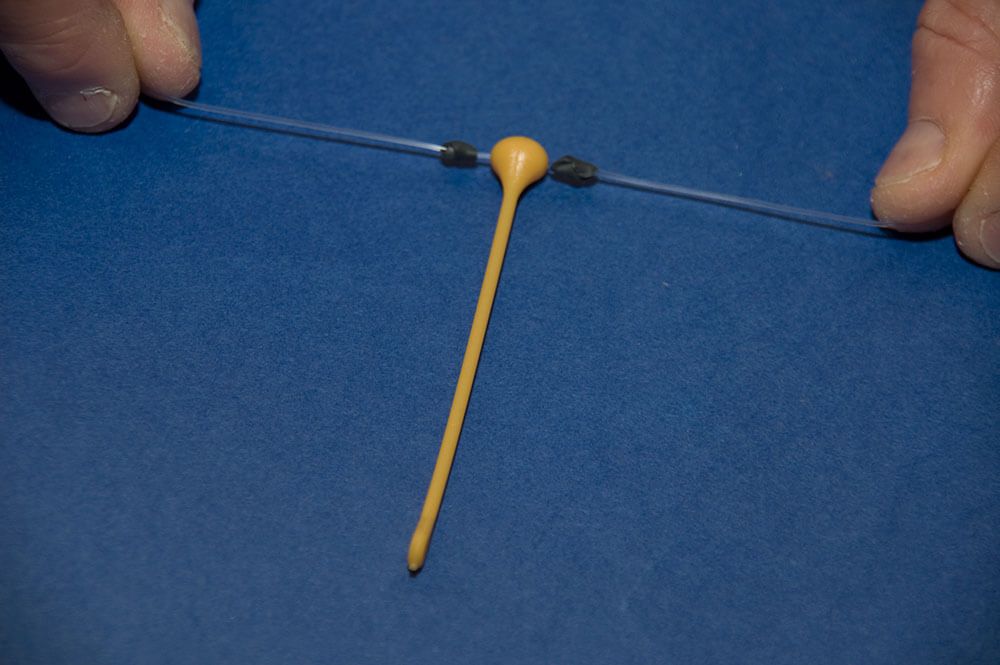
3. Slide on a paternoster style boom and another neoprene rig stop. Add two more separate rig stop and boom combinations to give you three booms on the rig body.
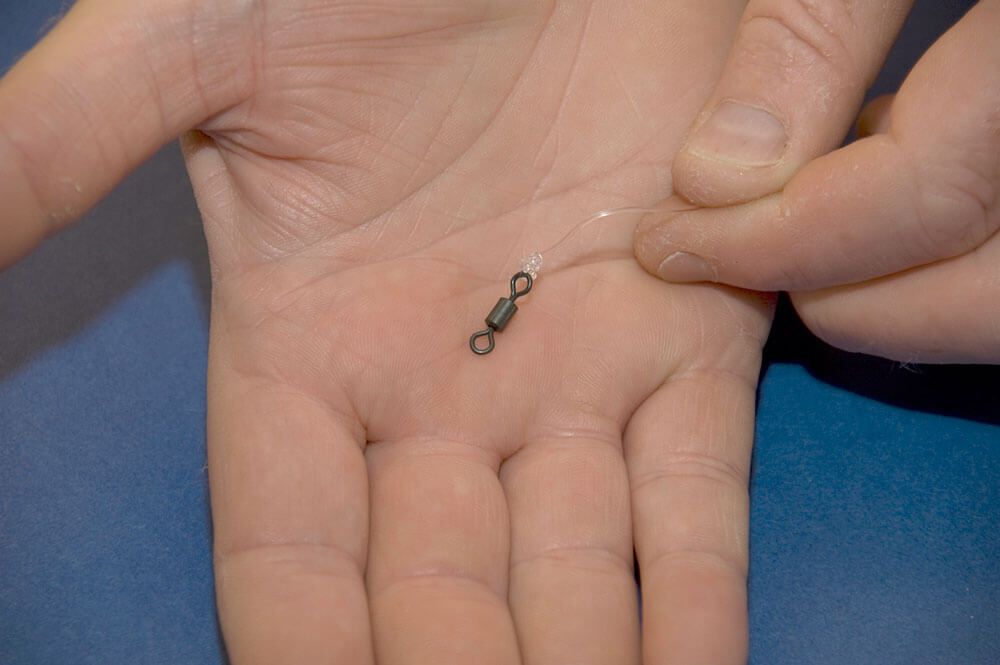
4. Complete the rig with a size 4 rig connector swivel.
5. Slide the rig stops into position on the rig to space the booms apart evenly. A good combination is to place one boom at the top, one in the middle and one just above the lead link.
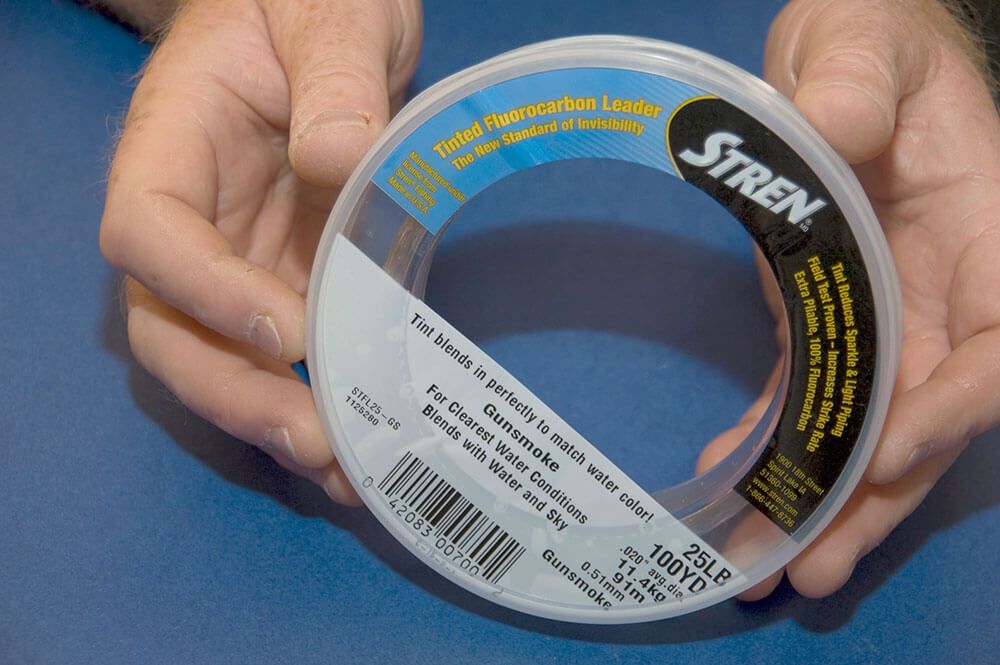
6. To the booms tie on short 9 to 12-inch 12 to 25lb hook snoods. Fluorocarbon hook snoods work best in all conditions, but mono is okay.
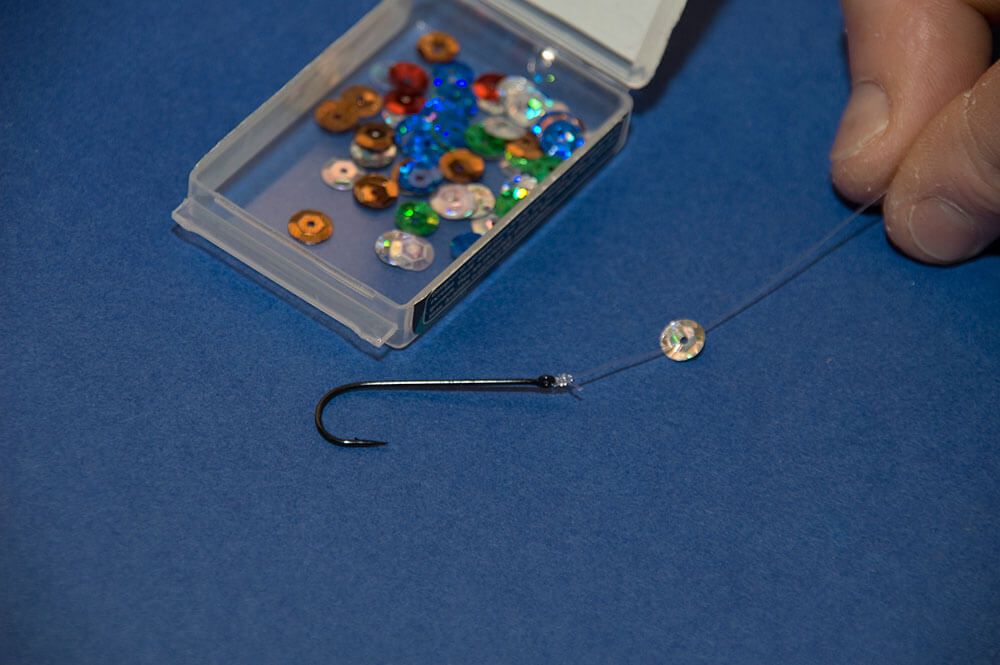
7. Sequins or pearl beads above the hook can also give you an edge when fishing clear water conditions. Silver and gold sequins are excellent choices for daylight fishing, with luminous yellow/green beads a good night time banker.
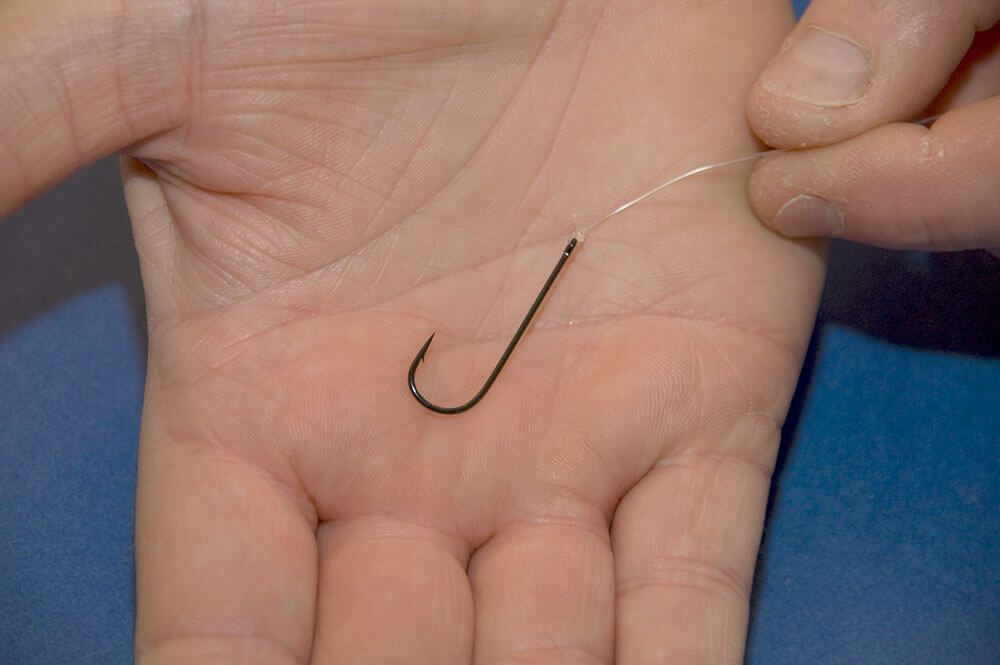
8. Hooks should be an Aberdeen pattern in size 2 to 6. Drop down to size 6's if bites are few and far between.
9. Having the booms able to slide via the neoprene stop knots means you can adjust the booms to fish baits closer together to increase the scent trail, or position two booms closer together to put two baits hard on the seabed if the fish are intent only on taking food from the lower hook and ignoring the other baits.
Follow our guide on how to make a three hook boom flounder rig in our Sea Fishing Rigs section.
The top surf bait for flounder has to be lugworm all year round, with peeler or soft crab a close second from March through to October. White rag and maddies are also excellent in the surf, again all year round. King rag is less reliable but does catch well at times.
After winter storms flounder move into the surf to feed on broken shellfish, so tipping worm baits with cockle, mussel, clam and razorfish can increase your catch rate dramatically in this situation.
From October on some of the biggest flounder take fish baits such as mackerel, sand eel and bluey, so whatever bait you have on the day will work if you're in flounder country.
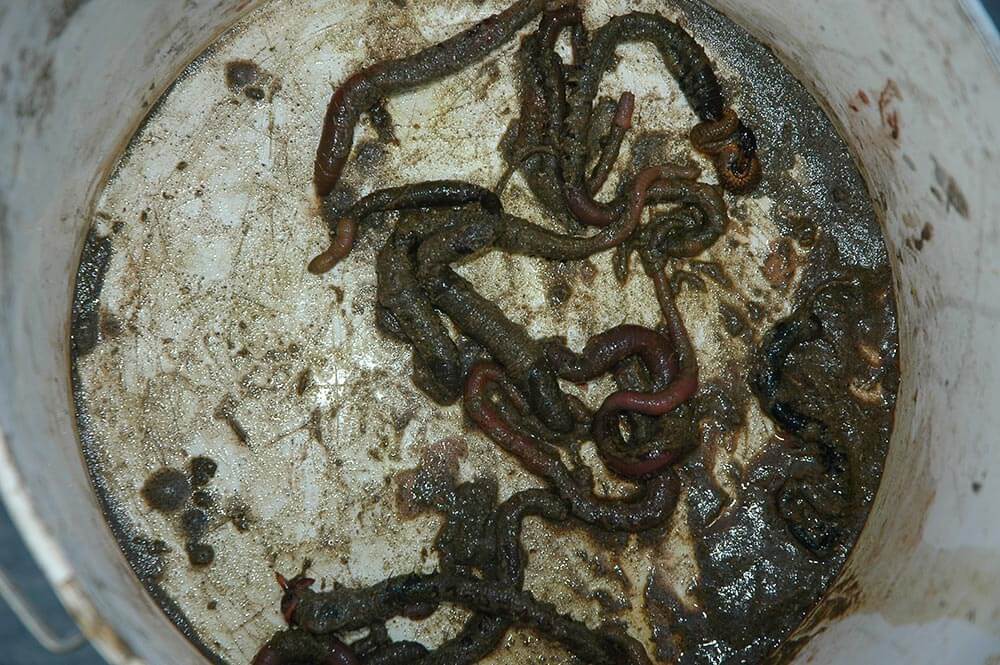
Juvenile flounder will be resident all year round, but the primary season for the adult fish is from mid-May in most areas right through until Christmas. In the prolific Welsh and southwest of England estuaries, some of the very biggest fish are caught in January and February. However, these tend to be single big fish and the last to leave before spawning. There is also an overlap of returning spawned out fish and the last fat fish just heading out in March.
Flounder feature inside the smallest estuaries just a hundred yards or so across right through to the big main water arteries such as The Thames and The Severn estuaries.
In the main estuary channel, they will be at the mouth of the estuary resident around seed mussel beds and sat inside the depressions caused by sandbanks and gutters. A hotspot will always be the deeper holes scoured out by the tide. Flounder tend to sit in these on the inclines of the banks where the tide run is deflected. They move into side creeks and drainage channels preferring to sit once again inside the deeper pools where the creek forms a corner typically sitting on the inside where the tide flow is minimal. They also travel into narrow side creeks and as the tide floods will move out on to shallow saltmarsh ground to feed over mud. Flounder can often be seen sunning themselves in a few inches of water right at the top of the tide line when living in estuary creeks. They also favour shallow harbours living in scoured out holes and on mud and shingle beds.
Flounder are also tolerant of freshwater and will travel many miles inland up into main rivers, sometimes as much as 40 or 50 miles away from the sea to be caught by coarse fisherman.
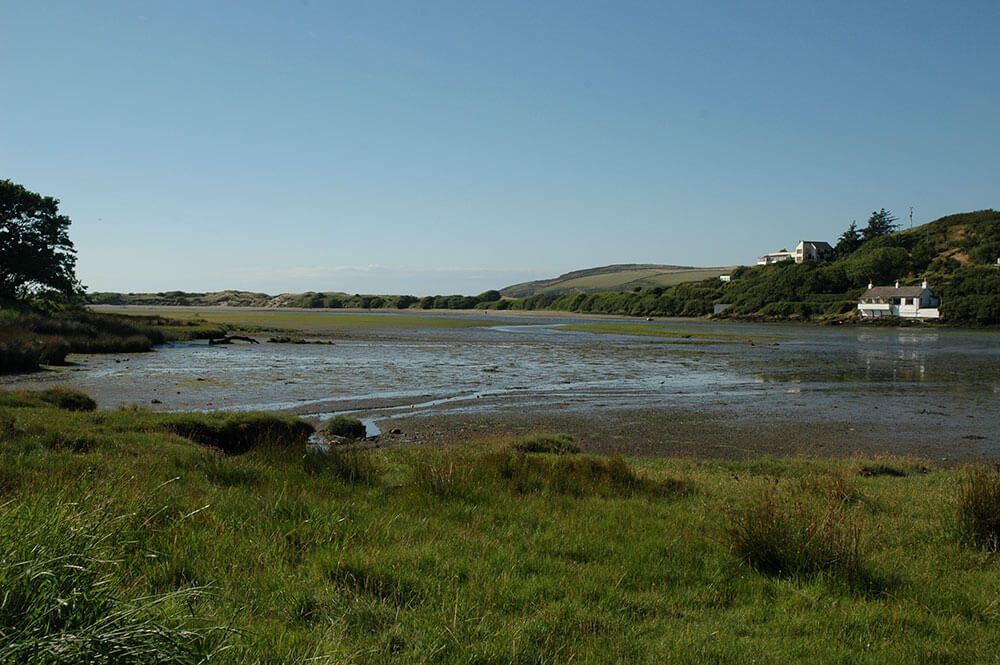
In estuaries where tide flow is minimal, a spinning rod casting 1 to 3ozs or a mullet rod is perfect. Match this to a size 4000 fixed spool loaded with 15 to 20lb braid line, adding a clear 20lb Fluorocarbon leader of about 15ft. Leads need to be no more than 2ozs, breakaways or plain bombs, depending on the tide run. This tackle is more than adequate as the fish are often right at your feet, rarely is a longer cast than 50yds required.
In faster tides and deeper water, or when casting distance is required, go for a bass rod, a 4000 sized fixed spool or a small casting multiplier around the 5500 size loaded with 15lb mono line with a 30lb shock leader. You may need 3 to 4oz grip leads in these conditions.
How to tie a three-hook boom rig

1. Start the rig with 60-inches of clear 60lb rig body line and tie a lead link to one end.

2. Slide on a short section of neoprene tubing and double the line back through the tubing then pull tight to form a sliding rig stop.

3. Slide on a paternoster style boom and another neoprene rig stop. Add two more separate rig stop and boom combinations to give you three booms on the rig body.

4. Complete the rig with a size 4 rig connector swivel.
5. Slide the rig stops into position on the rig to space the booms apart evenly. A good combination is to place one boom at the top, one in the middle and one just above the lead link.

6. To the booms tie on short 9 to 12-inch 12 to 25lb hook snoods. Fluorocarbon hook snoods work best in all conditions, but mono is okay.

7. Sequins or pearl beads above the hook can also give you an edge when fishing clear water conditions. Silver and gold sequins are excellent choices for daylight fishing, with luminous yellow/green beads a good night time banker.

8. Hooks should be an Aberdeen pattern in size 2 to 6. Drop down to size 6's if bites are few and far between.
9. Having the booms able to slide via the neoprene stop knots means you can adjust the booms to fish baits closer together to increase the scent trail, or position two booms closer together to put two baits hard on the seabed if the fish are intent only on taking food from the lower hook and ignoring the other baits.
Follow our guide on how to make a three hook boom flounder rig in our Sea Fishing Rigs section.
Estuary flounder baits go by season. In the March to September period peeler or soft crab is always the most reliable. However, flounder will take lugworm, ragworm and maddie rag to a lesser degree.
When the autumnal gales start, and the flounder move down into the main estuary creek crab is still good, as are the worm baits, but they will also feed on razorfish, clams and mussels. Never ignore mackerel strip as bait for flounder as they take it eagerly in the later year, especially either side of Christmas. Try tipping a mackerel strip with maddie rag. It is deadly! Big estuary flounder also like a section of peeler crab tipped with mackerel.
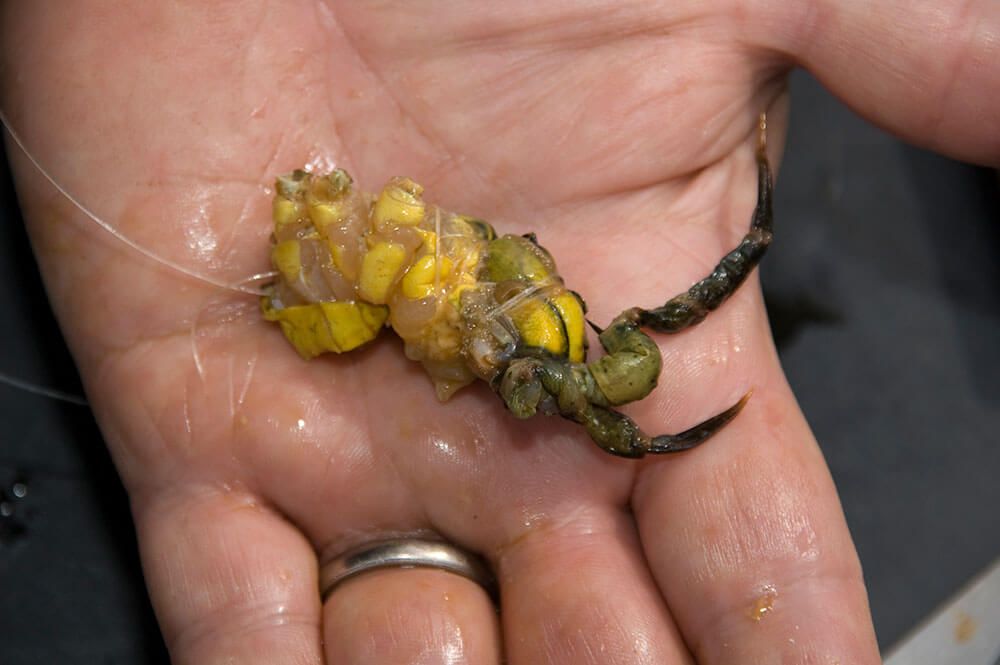
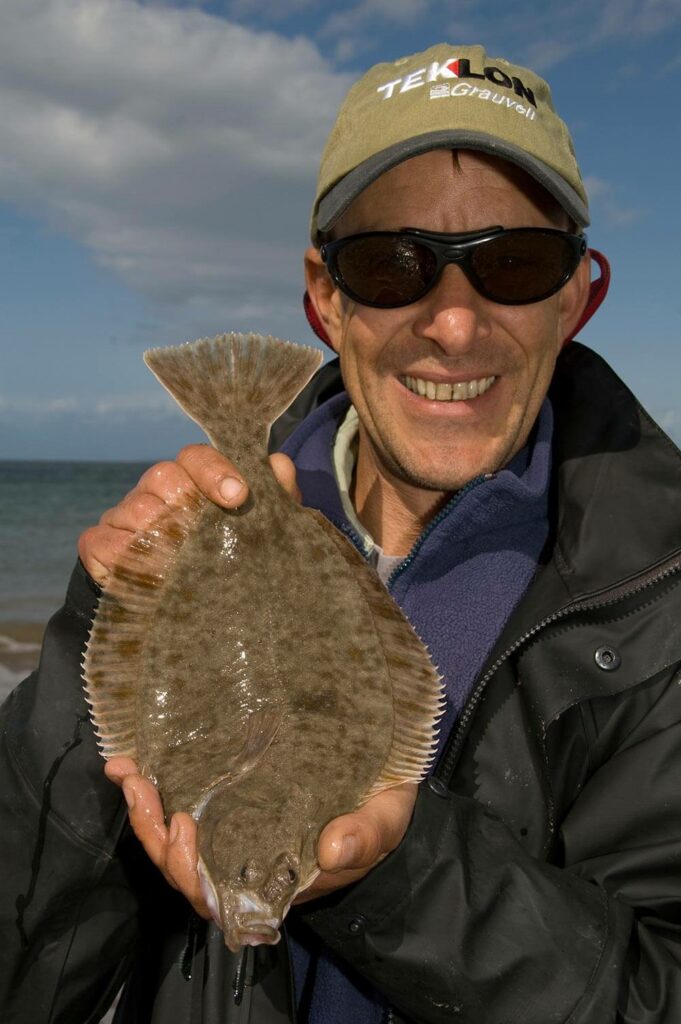
Most flounder fishing is done from the shore, but using a small boat to access areas within harbours and estuaries where there is less boat and human activity can be a major advantage and produce not only better catches, but also help you pick out areas where undisturbed flounder get the chance to grow bigger.
Ideal boats are the smaller dinghies in the 10ft to 14ft range with a shallow draft. These can be easily handled by one man but will also accommodate two anglers in the case of the 12ft to 14ft craft. The shallow draft means they can float and work in very shallow water and are easily manoeuvred into smaller tight estuarial creeks and bays with minimal noise, which is very important. Smaller outboard motors can be used to get you near to the places you want to fish, but the most successful tactic is to kill the motor well before you get to your fishing area, then use oars, either conventionally, or as punt poles, to finally position yourself. Also, when dropping anchors, place the anchor in the water and release the anchor rope in a controlled manner and feel for it gripping. Throwing anchors in and making lots of noise will scatter any close by flounder and you've effectively scattered any fish far and wide and killed your fishing for an hour or two.
Noise is also a factor when fishing. Shuffling your feet on a bare deck, dropping bait buckets, clattering rods and lead weights on the gunnels and even talking loudly can have an adverse effect on fish when you're fishing very shallow water and casting to close range. Always bear it in mind to be as quiet as possible so as not to scare the fish.
Tackle can be straightforward for upper estuary fishing, or when fishing tight into banks. A 9ft spinning rod casting up to 2ozs in combination with a 4000 sized fixed-spool reel gives a balanced outfit. Load the reel with 15lb braid and add a clear mono or Fluorocarbon 15lb shock leader twice the length of the rod. The braid is the best choice of line because being thin, it will cut through any tide better, but more importantly, it will give the best bite indication. Often, in smaller estuaries away from the main tidal run, the water clarity can be quite clear, especially on the flood tide. The clear shock leader helps to minimise any visual issues fish may have when approaching a bait.
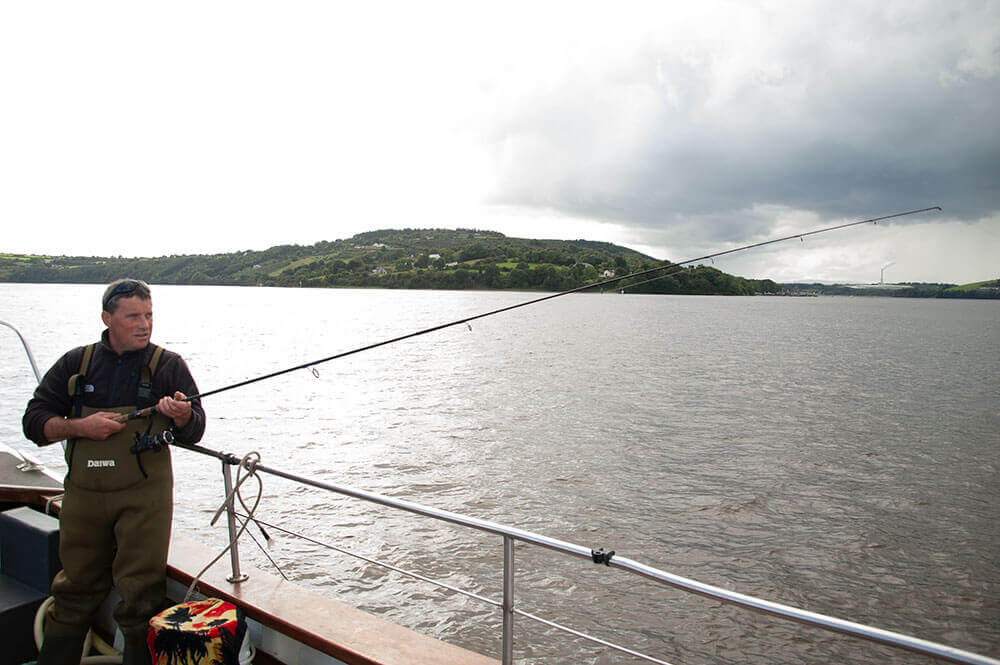
As for rigs, the deadliest is a simple sliding ledger rig with a flowing trace to present the bait naturally, but we need to adapt this to suit different ways of fishing.
If you're fishing small estuary creeks or even main channels, then allowing the rig to roll down the sides of the creeks and into the main channel can be deadly. To do this, choose a 1oz to 2oz ball-weight and slide this on to the leader followed by a 5mm bead and then tie on a size 4 rolling swivel. The hook length should be 20-inches of 12lb Fluorocarbon and finish the rig by tying on a size 2 Aberdeen pattern hook. The Fluorocarbon hook length, in Talk Sea Fishing's opinion, is better than mono for the simple reason it's tougher and more resilient if it comes in contact with stones, mussel beds or other snags littering the seabed. The round ball-weight can easily be moved either by the tidal current on the line if you adjust the weight accordingly, or by moving the rod tip to add movement to the bait and to reposition it occasionally after casting. Letting the bait roll around helps locate more fish, too.
The second rig type is the same sliding ledger system, but this time it incorporates a carp type flat lead. Slide the leader through the leads inner tube, slide on a small 5mm bead and tie on a size 6 swivel. Again add 20-inches of 12lb Fluorocarbon for the hook length and an Aberdeen pattern hook. This is the rig for casting into deeper channels where there is a flowing current and when you want to specifically position the bait tight in an eddy of water on a bend in the channel or creek, or against the incline of a bank where flounder will lay. The lead being flat means it will sit tight on the seabed and not move unless you move it by rod tip action.
Both the above rigs also give excellent bite detection and help avoid the flounder being deep hooked if you stay vigilant to bites showing on the rod tip and strike accordingly.
Baits are the same as when shore fishing. The top bait is small chunks of fully shelled peeler crab about the size of a 10p piece formed as sausage shapes using thin bait elastic then fed on to the hook much as you would a worm. To make sure the hook point is kept clear, slide on to the point a peeler crab claw or a couple of peeled legs. This disguises the hook point but also makes the bait look a little more natural, as well as ensuring the hook point is free to find a hook hold on the strike. Small soft crab is also a very good flounder baits in these estuary situations.
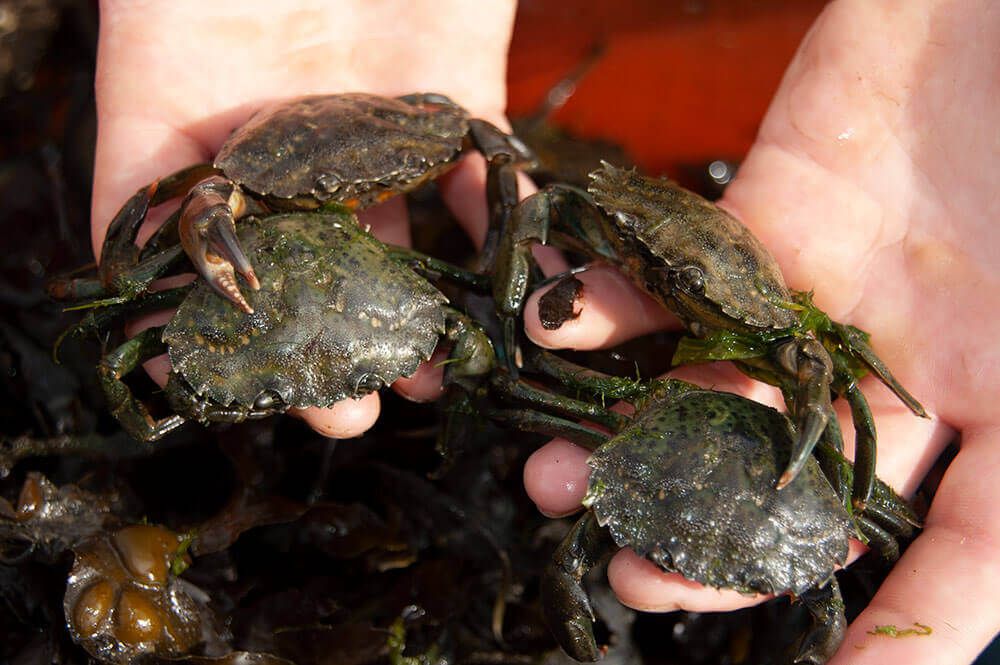
Other good baits include blow lugworm, fresh mussel, fresh cockle, razorfish, and in the colder months, mackerel strip can be deadly. One other bait stands out, and that is maddie or harbour rag. These can be fished in small bunches just hooked by the head to allow the rest of the body to wriggle enticingly. These are especially deadly in clear water and when fished in the quieter bays and side creeks where tidal flow is gentle.
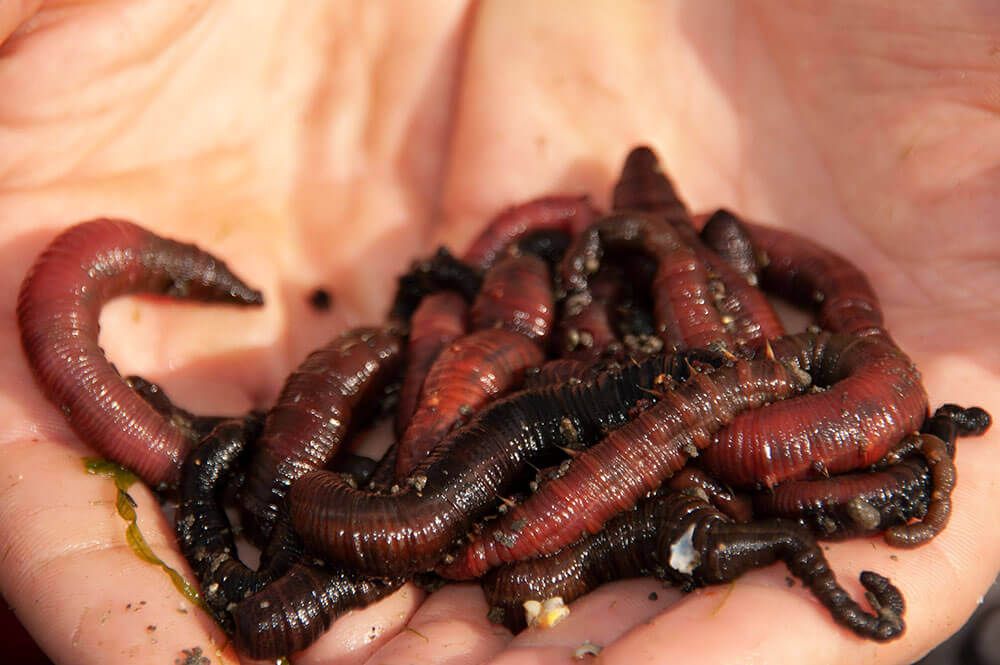
Inside both estuaries and harbours, the bulk of the fish will be caught on the flood tide. Often, in main estuary channels and harbour access channels, the fishing will be better on the smaller neap tides when the tidal flow is less severe. Even in the upper reaches of the estuary, the fish will move less during the neap tides. However, these smaller tides see the flounder well spread as they can stay on ground that would normally be dry during the bigger tides.
During the spring tides, expect the flounder to be more concentrated, especially either side of low water in the tidal channels, but also, they will be more tightly grouped as feeding ground uncovers for a less amount of time.
The first two hours of the flood tide are often the best, with the hour before high water another good period, but expect fish to be caught throughout the tide if you are prepared to move with the fish as they access the side creeks and shallower mudflats from the main channels.
Most boat fishing, for safety reasons, will be in daylight. It is the best time for flounder fishing but try and pick overcast days with no sunlight if you're fishing shallower water or the side creeks. If it's sunny and clear, target the deeper water channels and fish the inclines of the deeper sandbanks.
Having enough breeze to ripple the water as it floods also helps to cut down on the light entering the water column, and this is another advantage when you're fishing shallow water.
If there has been heavy rain and floodwater, then forget the upper estuary creeks and stick to the mouth of the estuary or target a deeper harbour where the effects of floodwater are lessened.
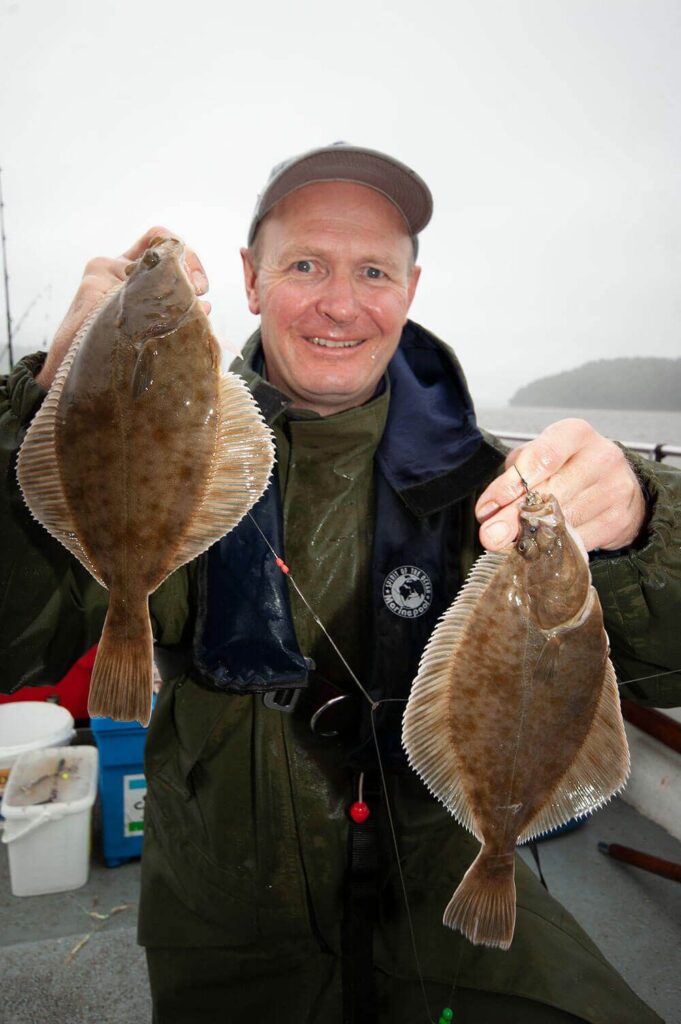
The best places to look inside small harbours are in the deeper main boat access channels. Look for any deviation or change in the direction of the channel and fish on the inside edge and downtide of the corner where there will be either a back eddy or a slack area of water. The flounder sit just on the inner edge of the current here looking to pick off bits of food that are washed passed.
Another good spot is where boats are moored up. Look to cast into the shadow of the boat hulls as flounder do like cover, especially in bright sunny weather. Another good spot is near the anchor chains as these hold seed mussels and also shoals of shrimp. Plus, as the boats swing on their mooring ropes and the chains huff up the sand, this causes small items of food to be exposed, such as worms, and the flounder will feed on these.
A top spot in harbours are the bigger mooring buoys. These have major anchors in the sandy mud and act like FAD's (Fish Aggregating Devices) and prove to be consistent larders for feeding flounder.
Breakwaters often protect harbours, and these often have a fast-tidal current pushing around the end of them. This can sometimes see sandbanks appear on the inside of the current as you enter a harbour. If you anchor up over the sandbanks and fish the inclines of these banks, you'll pick up flounder, especially either side of low water before the flounder move out into other ground and inside the harbour itself.
One last tip is to try and locate areas where there is mud in the sand or pure mud as opposed to just sand. The flounder will favour where the mud is more prolific than when the ground is just clean sand.
In smaller estuaries, such as those typically found on the west coast of Wales and in Cornwall, also Scotland, on the East Coast and throughout Ireland, the sides of the main channel are likely to be clean sand or mud. The flounder sit in the deeper main channel until the tide begins to flood, then will move out on to the shallower ground and feed right in amongst the surf line. This is where food will be disturbed. Small boats anchored out on the edge of the channel and casting on to this shallow ground and into the back edge of the surf can take a lot of flounder right up to high water. Once the tide starts to ebb, the flounder begin to retreat to the main channel, but some will still be caught as they push back.
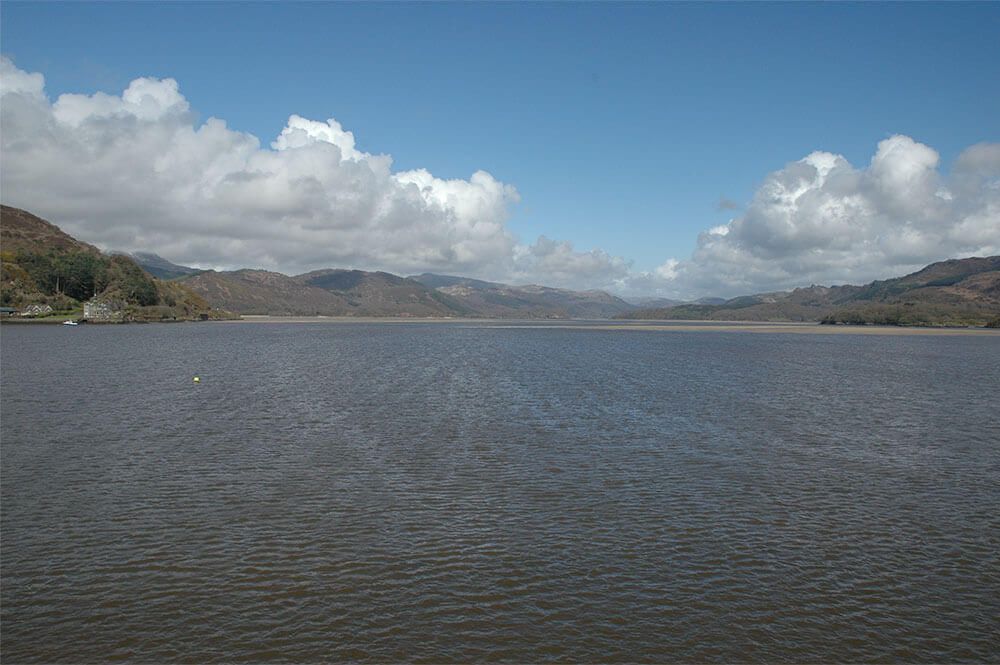
Again, the deeper main channels tend to fish best either side of low water on the inside of any bends in the channel. The flounder lay up here, out of any current and pick off passing food. As the tide floods in, they move out into the side creeks and even on to the shallower mudflats alongside the estuary.
If the side creeks are deepish, then the flounder will stay in these even when the tide ebbs and choose to lay on the inclines of the creek sides. By anchoring mid-channel and casting away from the boat to let the bait trot down the inclines, you can pick up a lot of fish, especially as the bait reaches the defined line of flat creek bottom and rising bank, which is always a hotspot.
Another prime spot is the edges of creeks and main channels where bladderwrack seaweed grows. This is crab country and big flounder, much like bass, will work the edge and inside the weed looking for crab and other food. They also choose to lay up here in shallow depressions they make themselves. This applies to when the tide is flooding mainly unless there is enough water for the flounder to stay there either side of low water. Once high tide is reached, then the flounder will quickly drop back to deeper water and settle down in the muddy sand for the ebb tide.
Further up the estuary, if you anchor within casting distance of the entrance to a side creek and put a bait right in the middle, you'll ambush flounder as they swim into the side creek. Also, look for muddy banks that cover from mid-tide on and fish these by anchoring away from them and casting baits directly on to the banks. If seaweed grows right to the edge where trees and bushes start to appear, or weed grass is evident, you'll often find the flounder right on the very edge of this shoreline feeding in just inches of water.
Also, pay attention to where small streams or trickles of freshwater run off the land over mud and into the deeper side creeks and channels. The flounder will collect around these, but if there has been recent heavy rain and this incoming water is very coloured, move well away from it as the flounder do not like this acidic floodwater carrying heavy waterborne silt.
One last thing to remember is that flounder are not that social inside estuaries. If you catch a fish from a spot on the edge of a side creek on an inclining bank say in amongst weed, then the next cast needs to be made to a new spot away from where you've just caught. Flounder laying up like space and are rarely in close proximity to each other. It's different when fishing the channels, and the mudflats as the fish are continually moving through.
Flounder bites are pretty simple affairs, but it pays to understand how they feed. The flounder smells the bait, or sees some movement, and follows it up. As it comes to the bait, it will suck it in, and if it's a bit big, it tries to cram as much of the bait into its mouth as it can. This will see the rod tip shudder and maybe dip a few times. Only strike when the rod tip pulls down three or four times in quick succession. This indicates the flounder has accepted the bait and is swimming away with it. If your presentation is correct and the hook point clear, you'll hook the fish by striking now without deep hooking it.
About flounder
Fishing for flounder is a rewarding pastime. They're one of the easiest species to catch, abundant and in areas that even the most novice sea angler can easily target. Preferring to hunt close to the shoreline of beaches, estuaries and creeks, they can often be fished for just a few yards out and with simple tactics. Ask a sea angler what fish they first recall catching, and it will likely be a flounder. In this guide, we take a look at how to target flounder from the beach, estuary and a boat.
Although the flounder is quite distinct, there can be confusion between this, the plaice and the dab.
The main difference with the flounder is that it has a series of prickles along the forward lateral line just above the pectoral fin. If you look at the plaice, this has a series of raised bony knobs. The dab has neither of these but look at the lateral line above the pectoral fin, and this shows a clear high upwards curve and is unique to the dab.
A common mistake made by anglers is wrongly identifying a flounder as a plaice because it has faint orangey/yellow spots on the topside. Both can show orangey-yellow spots on the back, though typically those on the plaice are much more defined, those on the flounder are diffused and lacking real colour. Flounder can occasionally cross breed with plaice.
Flounder can vary a little in colour. Over sand, they can be a light fawn to dark brown, but when living on mud or shingle will take on a grey/green colouration, sometimes with darker mottling.
Though an inshore fish, flounder migrate offshore into deep water to spawn. This is typically in the period from November to March. They begin returning as thin, spent fish as early as mid-March in the south, but typically mid-April further north.
Their diet is made up of worms, broken shellfish including cockles, clams, mussels and razorfish, shrimps, crabs, but they are also somewhat predatory. They will take small fish such as sand eels and fry.

How to catch a beach flounder
Location and when to fish
Flounder is one of our commonest and most adaptive fish being found throughout the British Isles, and also all around the coast of Ireland. They are also found as far north as the Faroe Islands and the southern tip of Iceland, and from the Russian border south taking in Norway and the western coast of Europe down to the Mediterranean.
Although flounder can be caught throughout the year in most areas, the recognised season for flounder fishing is from March when the spent fish return, to February when the bulk of the fish have moved offshore. The best period for the biggest fish is from October as the first real frosts arrive through to late January. At this time the fish are fully fat after a summer feeding and are powerful deep, thick-set fish.
They are found in higher numbers on the beaches adjacent to estuaries but can also be caught on open beaches well away from any freshwater influence. They favour clean sand, or mud and sand mixes, but will also happily live tight into mussel beds and in amongst rocks and boulders on small patches of clean sand.
Good spots on open beaches to locate flounder are small freshwater streams that flow across the beach, but only if the water is clear. If such water carries colour and is acidic from the mountains, or peat stained when in Ireland, then fish move away from these to purer water. Flounder, like so many other fish, hunt the parallel gullies that many storm beaches have, and will also settle down in hollows and deeper gutters feeding on foodstuffs washed down to them.
Flounder move inshore with the tide and feed right in amongst the last two surf tables happy in shallow water just a few inches deep. They drop back with the ebbing tide but do not move far away from the surf tables and are often one of the few fish that will continue to feed well as the tide ebbs away.
There is a myth that flounder do not feed at night. Flounder are masters of camouflage and care little whether its daylight or dark. Often the biggest flounder are caught at night when they venture closest in along the surf beaches, and especially after a good blow has ripped shellfish from the sand in the autumn.

Tackle
The majority of flounders caught by anglers are taken on heavy 4-6oz beachcasters when fishing for other species. But for most situations, you can fish a lot lighter. A good bass rod capable of casting either 1 to 3ozs or 2-4ozs is a good choice matched to a 6000 sized fixed spool or light multiplier reel. Load these reels with just 12lb line and a 30lb shock leader as casting distances will be no more than 50yds.
More experienced anglers go as light as a 9ft spinning rod, and a 4000 sized fixed spool reel loading with 10lb braid or mono and fish light lead weights no more than an ounce when appropriate to maximise sport. A simple sliding flowing trace rig with a size 2 Aberdeen works well with this combination when fishing up to 50yds out in the advancing surf tables.
How to tie a three-hook boom rig

1. Start the rig with 60-inches of clear 60lb rig body line and tie a lead link to one end.

2. Slide on a short section of neoprene tubing and double the line back through the tubing then pull tight to form a sliding rig stop.

3. Slide on a paternoster style boom and another neoprene rig stop. Add two more separate rig stop and boom combinations to give you three booms on the rig body.

4. Complete the rig with a size 4 rig connector swivel.
5. Slide the rig stops into position on the rig to space the booms apart evenly. A good combination is to place one boom at the top, one in the middle and one just above the lead link.

6. To the booms tie on short 9 to 12-inch 12 to 25lb hook snoods. Fluorocarbon hook snoods work best in all conditions, but mono is okay.

7. Sequins or pearl beads above the hook can also give you an edge when fishing clear water conditions. Silver and gold sequins are excellent choices for daylight fishing, with luminous yellow/green beads a good night time banker.

8. Hooks should be an Aberdeen pattern in size 2 to 6. Drop down to size 6's if bites are few and far between.
9. Having the booms able to slide via the neoprene stop knots means you can adjust the booms to fish baits closer together to increase the scent trail, or position two booms closer together to put two baits hard on the seabed if the fish are intent only on taking food from the lower hook and ignoring the other baits.
Follow our guide on how to make a three hook boom flounder rig in our Sea Fishing Rigs section.
Baits
The top surf bait for flounder has to be lugworm all year round, with peeler or soft crab a close second from March through to October. White rag and maddies are also excellent in the surf, again all year round. King rag is less reliable but does catch well at times.
After winter storms flounder move into the surf to feed on broken shellfish, so tipping worm baits with cockle, mussel, clam and razorfish can increase your catch rate dramatically in this situation.
From October on some of the biggest flounder take fish baits such as mackerel, sand eel and bluey, so whatever bait you have on the day will work if you're in flounder country.

Top five tips for surf beach fishing for flounder
- When fishing light tackle in light surf conditions, choose a flat watch type lead with a hollow centre. These can be periodically moved a few inches at a time across the seabed to disturb puffs of sand. Flounder are inquisitive and will move in to investigate this disturbance. This can even work at night if the water is shallow, clear and moonlit.
- When using a sliding ledger rig with a longish flowing trace, try adding a small metal or plastic silver spoon and a brightly coloured bead just above the baited hook. Very slowly, an inch or two at a time, retrieve the bait across the seabed. The fluttering action and colour of the spoon will attract flounder in to attack the bait as they think this is a small fish making off with food.
- It's best when fishing a three-hook boom or flapper rig to a tight line, to periodically pull off a good two or three feet of slack line. This drops the top baits down on the seabed, and this movement will often trigger flounder to take the bait. Watch the downward bow in the line for lift bites. This little trick is highly effective on days when fish are lethargic.
- Always use long shank Aberdeen hooks when fishing for fun, not short shanks. The longer shanked hooks are easier to retrieve from fish if they swallow a bait deep. If you find you're using size 2 Aberdeen's and the fish are taking the baits deep when they are particularly hungry, then go up a couple of hook sizes. You'll catch pretty much just as many but with fewer deep hooked fish.
- A good tip to draw flounder very close in within a few yards of your feet is to throw old bait off the hooks as you re-bait into the surf tables. This washes around, inwards and outwards, and the scent pulls flounder in from a wide area. This is a trick used by match anglers to draw fish in from an adjacent competitors peg to your own.
How to catch an estuary flounder
Location and when to catch flounder
Juvenile flounder will be resident all year round, but the primary season for the adult fish is from mid-May in most areas right through until Christmas. In the prolific Welsh and southwest of England estuaries, some of the very biggest fish are caught in January and February. However, these tend to be single big fish and the last to leave before spawning. There is also an overlap of returning spawned out fish and the last fat fish just heading out in March.
Flounder feature inside the smallest estuaries just a hundred yards or so across right through to the big main water arteries such as The Thames and The Severn estuaries.
In the main estuary channel, they will be at the mouth of the estuary resident around seed mussel beds and sat inside the depressions caused by sandbanks and gutters. A hotspot will always be the deeper holes scoured out by the tide. Flounder tend to sit in these on the inclines of the banks where the tide run is deflected. They move into side creeks and drainage channels preferring to sit once again inside the deeper pools where the creek forms a corner typically sitting on the inside where the tide flow is minimal. They also travel into narrow side creeks and as the tide floods will move out on to shallow saltmarsh ground to feed over mud. Flounder can often be seen sunning themselves in a few inches of water right at the top of the tide line when living in estuary creeks. They also favour shallow harbours living in scoured out holes and on mud and shingle beds.
Flounder are also tolerant of freshwater and will travel many miles inland up into main rivers, sometimes as much as 40 or 50 miles away from the sea to be caught by coarse fisherman.

Tackle
In estuaries where tide flow is minimal, a spinning rod casting 1 to 3ozs or a mullet rod is perfect. Match this to a size 4000 fixed spool loaded with 15 to 20lb braid line, adding a clear 20lb Fluorocarbon leader of about 15ft. Leads need to be no more than 2ozs, breakaways or plain bombs, depending on the tide run. This tackle is more than adequate as the fish are often right at your feet, rarely is a longer cast than 50yds required.
In faster tides and deeper water, or when casting distance is required, go for a bass rod, a 4000 sized fixed spool or a small casting multiplier around the 5500 size loaded with 15lb mono line with a 30lb shock leader. You may need 3 to 4oz grip leads in these conditions.
How to tie a three-hook boom rig

1. Start the rig with 60-inches of clear 60lb rig body line and tie a lead link to one end.

2. Slide on a short section of neoprene tubing and double the line back through the tubing then pull tight to form a sliding rig stop.

3. Slide on a paternoster style boom and another neoprene rig stop. Add two more separate rig stop and boom combinations to give you three booms on the rig body.

4. Complete the rig with a size 4 rig connector swivel.
5. Slide the rig stops into position on the rig to space the booms apart evenly. A good combination is to place one boom at the top, one in the middle and one just above the lead link.

6. To the booms tie on short 9 to 12-inch 12 to 25lb hook snoods. Fluorocarbon hook snoods work best in all conditions, but mono is okay.

7. Sequins or pearl beads above the hook can also give you an edge when fishing clear water conditions. Silver and gold sequins are excellent choices for daylight fishing, with luminous yellow/green beads a good night time banker.

8. Hooks should be an Aberdeen pattern in size 2 to 6. Drop down to size 6's if bites are few and far between.
9. Having the booms able to slide via the neoprene stop knots means you can adjust the booms to fish baits closer together to increase the scent trail, or position two booms closer together to put two baits hard on the seabed if the fish are intent only on taking food from the lower hook and ignoring the other baits.
Follow our guide on how to make a three hook boom flounder rig in our Sea Fishing Rigs section.
Baits
Estuary flounder baits go by season. In the March to September period peeler or soft crab is always the most reliable. However, flounder will take lugworm, ragworm and maddie rag to a lesser degree.
When the autumnal gales start, and the flounder move down into the main estuary creek crab is still good, as are the worm baits, but they will also feed on razorfish, clams and mussels. Never ignore mackerel strip as bait for flounder as they take it eagerly in the later year, especially either side of Christmas. Try tipping a mackerel strip with maddie rag. It is deadly! Big estuary flounder also like a section of peeler crab tipped with mackerel.

Top five tips for catching estuary flounder
- When baiting up with crab and fishing in very clear shallow water add two or three peeled legs to the hook point. This gives a natural-looking presentation and encourages the flounder to eat the bait from the hook point upwards, resulting in more hooked fish.
- Flounder respond to ground baiting. As you renew baits throw the old used bait into the tide edge and let it wash about. The smell will draw nearby flounders into the water right under your feet. You can also use a swim feeder or lead weight feeder and load with mashed up bread or bran with pilchard oil and minced up bits of old worm and mackerel. Also, try halibut pellets as these work well too. You can fish the swim feeder as the lead weight in light tide run areas.
- When using smaller baits such as maddie rag, if shore crabs are stripping the baits too quickly for the flounder to find the bait, add a couple of float beads above the hook to lift the bait off the seabed a little. Flounder, with their eyes on top of the body, will see the bait and rise off the seabed to intercept it.
- Flounder are attracted to movement. Always choose a lead weight light enough to either roll with the tide to cover as much ground as possible and find all the deeper holes and gutters where the flounder will sit. Alternatively, use a flat-shaped lead and periodically retrieve a few inches of line, then pause, to add movement to the bait and draw the fish in. Some anglers are now using lead weights dipped in luminous paint for this as it attracts the flounder in towards the bait, especially in low light levels.
- When working alongside creeks, the flounder will often be right on the edge of the tide line. In this situation, free lining baits such as crab and mussel, which have the weight to be cast short-range, can be deadly. Being a free lined bait, it makes a little splash but will behave more naturally in the tide without a lead weight. Let the bait wash around with the tide, and the fish will find it. Remember to keep a low profile when doing this as the flounder will be skittish when half-buried in the sand in just a few inches of water.

Boat fishing for flounder
Most flounder fishing is done from the shore, but using a small boat to access areas within harbours and estuaries where there is less boat and human activity can be a major advantage and produce not only better catches, but also help you pick out areas where undisturbed flounder get the chance to grow bigger.
Type of boats for flounder fishing
Ideal boats are the smaller dinghies in the 10ft to 14ft range with a shallow draft. These can be easily handled by one man but will also accommodate two anglers in the case of the 12ft to 14ft craft. The shallow draft means they can float and work in very shallow water and are easily manoeuvred into smaller tight estuarial creeks and bays with minimal noise, which is very important. Smaller outboard motors can be used to get you near to the places you want to fish, but the most successful tactic is to kill the motor well before you get to your fishing area, then use oars, either conventionally, or as punt poles, to finally position yourself. Also, when dropping anchors, place the anchor in the water and release the anchor rope in a controlled manner and feel for it gripping. Throwing anchors in and making lots of noise will scatter any close by flounder and you've effectively scattered any fish far and wide and killed your fishing for an hour or two.
Noise is also a factor when fishing. Shuffling your feet on a bare deck, dropping bait buckets, clattering rods and lead weights on the gunnels and even talking loudly can have an adverse effect on fish when you're fishing very shallow water and casting to close range. Always bear it in mind to be as quiet as possible so as not to scare the fish.
Tackle for boat flounder fishing
Tackle can be straightforward for upper estuary fishing, or when fishing tight into banks. A 9ft spinning rod casting up to 2ozs in combination with a 4000 sized fixed-spool reel gives a balanced outfit. Load the reel with 15lb braid and add a clear mono or Fluorocarbon 15lb shock leader twice the length of the rod. The braid is the best choice of line because being thin, it will cut through any tide better, but more importantly, it will give the best bite indication. Often, in smaller estuaries away from the main tidal run, the water clarity can be quite clear, especially on the flood tide. The clear shock leader helps to minimise any visual issues fish may have when approaching a bait.

As for rigs, the deadliest is a simple sliding ledger rig with a flowing trace to present the bait naturally, but we need to adapt this to suit different ways of fishing.
If you're fishing small estuary creeks or even main channels, then allowing the rig to roll down the sides of the creeks and into the main channel can be deadly. To do this, choose a 1oz to 2oz ball-weight and slide this on to the leader followed by a 5mm bead and then tie on a size 4 rolling swivel. The hook length should be 20-inches of 12lb Fluorocarbon and finish the rig by tying on a size 2 Aberdeen pattern hook. The Fluorocarbon hook length, in Talk Sea Fishing's opinion, is better than mono for the simple reason it's tougher and more resilient if it comes in contact with stones, mussel beds or other snags littering the seabed. The round ball-weight can easily be moved either by the tidal current on the line if you adjust the weight accordingly, or by moving the rod tip to add movement to the bait and to reposition it occasionally after casting. Letting the bait roll around helps locate more fish, too.
The second rig type is the same sliding ledger system, but this time it incorporates a carp type flat lead. Slide the leader through the leads inner tube, slide on a small 5mm bead and tie on a size 6 swivel. Again add 20-inches of 12lb Fluorocarbon for the hook length and an Aberdeen pattern hook. This is the rig for casting into deeper channels where there is a flowing current and when you want to specifically position the bait tight in an eddy of water on a bend in the channel or creek, or against the incline of a bank where flounder will lay. The lead being flat means it will sit tight on the seabed and not move unless you move it by rod tip action.
Both the above rigs also give excellent bite detection and help avoid the flounder being deep hooked if you stay vigilant to bites showing on the rod tip and strike accordingly.
Baits for boat flounder fishing
Baits are the same as when shore fishing. The top bait is small chunks of fully shelled peeler crab about the size of a 10p piece formed as sausage shapes using thin bait elastic then fed on to the hook much as you would a worm. To make sure the hook point is kept clear, slide on to the point a peeler crab claw or a couple of peeled legs. This disguises the hook point but also makes the bait look a little more natural, as well as ensuring the hook point is free to find a hook hold on the strike. Small soft crab is also a very good flounder baits in these estuary situations.

Other good baits include blow lugworm, fresh mussel, fresh cockle, razorfish, and in the colder months, mackerel strip can be deadly. One other bait stands out, and that is maddie or harbour rag. These can be fished in small bunches just hooked by the head to allow the rest of the body to wriggle enticingly. These are especially deadly in clear water and when fished in the quieter bays and side creeks where tidal flow is gentle.

Which tides to pick for boat flounder fishing
Inside both estuaries and harbours, the bulk of the fish will be caught on the flood tide. Often, in main estuary channels and harbour access channels, the fishing will be better on the smaller neap tides when the tidal flow is less severe. Even in the upper reaches of the estuary, the fish will move less during the neap tides. However, these smaller tides see the flounder well spread as they can stay on ground that would normally be dry during the bigger tides.
During the spring tides, expect the flounder to be more concentrated, especially either side of low water in the tidal channels, but also, they will be more tightly grouped as feeding ground uncovers for a less amount of time.
The first two hours of the flood tide are often the best, with the hour before high water another good period, but expect fish to be caught throughout the tide if you are prepared to move with the fish as they access the side creeks and shallower mudflats from the main channels.
Best weather
Most boat fishing, for safety reasons, will be in daylight. It is the best time for flounder fishing but try and pick overcast days with no sunlight if you're fishing shallower water or the side creeks. If it's sunny and clear, target the deeper water channels and fish the inclines of the deeper sandbanks.
Having enough breeze to ripple the water as it floods also helps to cut down on the light entering the water column, and this is another advantage when you're fishing shallow water.
If there has been heavy rain and floodwater, then forget the upper estuary creeks and stick to the mouth of the estuary or target a deeper harbour where the effects of floodwater are lessened.

Boat flounder fishing in harbours
The best places to look inside small harbours are in the deeper main boat access channels. Look for any deviation or change in the direction of the channel and fish on the inside edge and downtide of the corner where there will be either a back eddy or a slack area of water. The flounder sit just on the inner edge of the current here looking to pick off bits of food that are washed passed.
Another good spot is where boats are moored up. Look to cast into the shadow of the boat hulls as flounder do like cover, especially in bright sunny weather. Another good spot is near the anchor chains as these hold seed mussels and also shoals of shrimp. Plus, as the boats swing on their mooring ropes and the chains huff up the sand, this causes small items of food to be exposed, such as worms, and the flounder will feed on these.
A top spot in harbours are the bigger mooring buoys. These have major anchors in the sandy mud and act like FAD's (Fish Aggregating Devices) and prove to be consistent larders for feeding flounder.
Breakwaters often protect harbours, and these often have a fast-tidal current pushing around the end of them. This can sometimes see sandbanks appear on the inside of the current as you enter a harbour. If you anchor up over the sandbanks and fish the inclines of these banks, you'll pick up flounder, especially either side of low water before the flounder move out into other ground and inside the harbour itself.
One last tip is to try and locate areas where there is mud in the sand or pure mud as opposed to just sand. The flounder will favour where the mud is more prolific than when the ground is just clean sand.
Boat estuary flounder fishing tactics
In smaller estuaries, such as those typically found on the west coast of Wales and in Cornwall, also Scotland, on the East Coast and throughout Ireland, the sides of the main channel are likely to be clean sand or mud. The flounder sit in the deeper main channel until the tide begins to flood, then will move out on to the shallower ground and feed right in amongst the surf line. This is where food will be disturbed. Small boats anchored out on the edge of the channel and casting on to this shallow ground and into the back edge of the surf can take a lot of flounder right up to high water. Once the tide starts to ebb, the flounder begin to retreat to the main channel, but some will still be caught as they push back.

Again, the deeper main channels tend to fish best either side of low water on the inside of any bends in the channel. The flounder lay up here, out of any current and pick off passing food. As the tide floods in, they move out into the side creeks and even on to the shallower mudflats alongside the estuary.
If the side creeks are deepish, then the flounder will stay in these even when the tide ebbs and choose to lay on the inclines of the creek sides. By anchoring mid-channel and casting away from the boat to let the bait trot down the inclines, you can pick up a lot of fish, especially as the bait reaches the defined line of flat creek bottom and rising bank, which is always a hotspot.
Another prime spot is the edges of creeks and main channels where bladderwrack seaweed grows. This is crab country and big flounder, much like bass, will work the edge and inside the weed looking for crab and other food. They also choose to lay up here in shallow depressions they make themselves. This applies to when the tide is flooding mainly unless there is enough water for the flounder to stay there either side of low water. Once high tide is reached, then the flounder will quickly drop back to deeper water and settle down in the muddy sand for the ebb tide.
Further up the estuary, if you anchor within casting distance of the entrance to a side creek and put a bait right in the middle, you'll ambush flounder as they swim into the side creek. Also, look for muddy banks that cover from mid-tide on and fish these by anchoring away from them and casting baits directly on to the banks. If seaweed grows right to the edge where trees and bushes start to appear, or weed grass is evident, you'll often find the flounder right on the very edge of this shoreline feeding in just inches of water.
Also, pay attention to where small streams or trickles of freshwater run off the land over mud and into the deeper side creeks and channels. The flounder will collect around these, but if there has been recent heavy rain and this incoming water is very coloured, move well away from it as the flounder do not like this acidic floodwater carrying heavy waterborne silt.
One last thing to remember is that flounder are not that social inside estuaries. If you catch a fish from a spot on the edge of a side creek on an inclining bank say in amongst weed, then the next cast needs to be made to a new spot away from where you've just caught. Flounder laying up like space and are rarely in close proximity to each other. It's different when fishing the channels, and the mudflats as the fish are continually moving through.
Interpreting bites when afloat
Flounder bites are pretty simple affairs, but it pays to understand how they feed. The flounder smells the bait, or sees some movement, and follows it up. As it comes to the bait, it will suck it in, and if it's a bit big, it tries to cram as much of the bait into its mouth as it can. This will see the rod tip shudder and maybe dip a few times. Only strike when the rod tip pulls down three or four times in quick succession. This indicates the flounder has accepted the bait and is swimming away with it. If your presentation is correct and the hook point clear, you'll hook the fish by striking now without deep hooking it.

